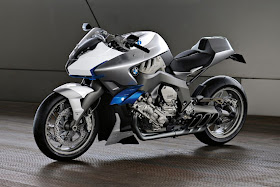
2010 BMW Concept 6
Fascination, Supremacy and Riding Comfort with Six Cylinders.
Munich. Six-cylinder power units have always had particular appeal, offering not only supreme smoothness and refinement, but also superior power and performance as well as a truly emotional driving – or, in this case, riding – experience. A further point is that the typical sound of a straight-six almost like a turbine is absolutely incomparable, with straight-six power units at BMW having stood for fascinating engine technology in BMW cars for more than seven decades.
Looking at motorcycles, inventive engineers have also tried time and again to offer the enthusiast the thrilling concept of a straight-six power unit. But while a few engines in straight-six configuration have indeed been fitted in motorcycles both lengthwise and crosswise, the straight-six has never really made a genuine breakthrough neither on production models nor in motorcycle racing.
Depending on the way the engine was fitted, six cylinders in-line inevitably made the engine either very long or very wide, creating disadvantages in terms of the running gear, weight distribution, and the centre of gravity. A further drawback was much higher engine weight usually setting off the benefits of extra engine power.
The BMW Concept 6 now proves that a straight-six, benefiting from the most advanced construction and production technology, may offer not only unique prestige, but also a supreme standard of riding dynamics.
The new BMW straight-six will further expand the K-Series in the foreseeable future. The first model to be introduced will be an innovative and luxurious BMW touring machine. Reflecting the tradition of the BMW K-Series, this will of course be a genuine top-of-the-line product.
Highly compact and dynamic six-cylinder.
The starting point for this dynamic introduction of the straight-six in the new Concept 6 from BMW Motorrad is of course the extremely compact form and configuration of the engine. The power unit is approximately 100 mm or 4" slimmer than all former straight-six production engines and only a bit wider than a large-capacity straight-four with conventional technology.
The reduction in width is achieved in particular by the slightly over-square bore: stroke ratio with relatively long stroke and very small gaps between cylinders. To achieve this very compact configuration with minimum width, the electrical ancillaries and their drive components are positioned behind the crankshaft in the open space above the transmission.
High-tech lightweight construction in all areas serves to make the power unit relatively light from the outset, important components in this context being the two hollow-drilled camshafts and the very light connecting rods. The perfect compensation of masses ensured by the configuration and layout of the engine avoids the need for a balance shaft and its drive elements on the new straight-six, which again means lower weight and enhanced running smoothness.
In its layout, the straight-six featured in the Concept 6 follows the well-known straight-four in the K 1300 model series, again coming with cylinders tilted to the front by 55o. This ensures not only a low centre of gravity, but also very good weight balance as an element essential above all under sporting conditions for precise feeling and clear feedback from the front. A further advantage is that the tilted engine provides extra space for the aerodynamically positioned intake manifold directly above the engine and allows ideal configuration of the frame profiles following the flow of power.
The straight-six featured in the BMW Motorrad Concept 6 comes with dry sump lubrication. Apart from greater reliability even under extreme conditions, dry sump technology serves to keep the crankcase particularly low and flat, with the engine being fitted lower down and masses concentrated around the centre of gravity. Doing without an oil sump, the engine may be positioned far lower than on a conventional layout.
The oil reservoir is provided by an oil tank integrated at the rear of the engine block. This avoids the need for a separate tank, again helping to make the entire power unit more compact and reduce weight to a minimum.
Thanks to : totalmotorcycle.com


















